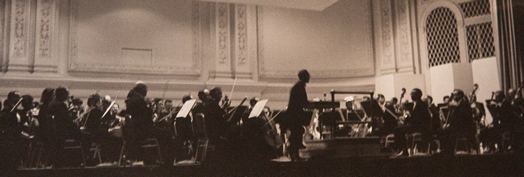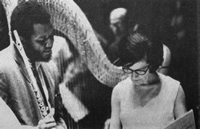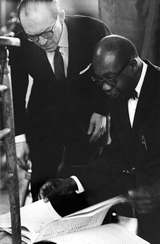Allegro
Open to All
How the Symphony of the New World made history
Volume 114, No. 2February, 2014

The Symphony of the New World’s debut concert on May 6, 1965 at Carnegie Hall.
The reality of musicians of all backgrounds playing together on the same stage may seem ordinary today. But under the cruel mantle of racism in this country, an integrated orchestra was only a dream for many years. It was something my father, Benjamin Steinberg, longed for and ultimately won, right here in New York City. The story of his dream – which was an ensemble called the Symphony of the New World – is one that many musicians may not know.
As early as 1940, my father began to work with conductors Dean Dixon and Everett Lee to establish the first fully-integrated professional symphony orchestra in the U.S. It took more than two decades. Flutist Harold Jones remembers, “There was a nucleus of people: Elayne Jones, Harry Smyles, Joe Wilder, Wilmer Wise, Kermit Moore, Lucille Dixon. We all got together and had these meetings. ‘Are we interested?’ Everyone jumped to the idea. ‘Yes. Let’s do this. We’re going to do it – have an integrated orchestra.’”
With my father as music director, the mission statement listed the other founders: Alfred Brown, Selwart R. Clarke, Richard Davis, Elayne Jones, Harold M. Jones, Frederick L. King, Kermit D. Moore, Coleridge-Taylor Perkinson, Ross C. Shub, Harry M. Smyles, and Joseph B. Wilder.
Finally on May 6, 1965, two months after the “Bloody Sunday” civil rights march from Selma to Montgomery, the Symphony of the New World performed its debut concert at Carnegie Hall.
The program notes for that inaugural concert stated, “At this period in our history, when the problem of racial integration has become crucial to our nation’s well-being as well as to its position in the world, the debut concert of the Symphony of the New World is a historic event in the history of our time.”

The late harpist Gloria Agostini consults with flutist Harold Jones during a rehearsal.
Trumpeter Wilmer Wise recalls, “Some people were crying because it was something we had dreamt about and it had finally come to fruition. I never felt in my life the way I did when I sat on the stage with Benjamin Steinberg in a fully integrated orchestra – because, usually, I was the one integrating it.”
From the beginning, one of the orchestra’s goals was to bring performances into the community – not just to Carnegie or Philharmonic Hall. Three days after Carnegie Hall, the symphony repeated the same program at the High School of Music and Art in Harlem.
Then came “the Lenny letter”:
October 11, 1965
Mr. Donald L. Engle, Director
The Martha Baird Rockefeller Fund for Music
1 Rockefeller Plaza
New York, New York
Dear Mr. Engle:
It is a pleasure for me to be able to recommend The Symphony of the New World for a sizable grant. I have not actually heard the orchestra perform. But I have heard and known Mr. Steinberg, who conducted one of my theatre works 15 years ago (“Peter Pan”). He is extremely able and gifted; and I am sure that under his guidance the orchestra will flourish. Most important of all, of course, is the sociological impetus behind the project – a truly integrated symphony orchestra. The success of this project will certainly stimulate more of the same, and may provide us with our first big step out of the unfair and illogical situation in which we now find ourselves with the Negro musician.
Respectfully yours,
Leonard Bernstein
They got the grant. Many successful concerts and collaborations followed. James DePriest became the symphony’s principal guest conductor. There were also breakthroughs. Marilyn Dubow, a soloist with the symphony, won a seat in the New York Philharmonic as the first female violinist. Elayne Jones, another symphony almnus, joined the San Francisco Symphony as its first black woman timpanist. Thinking back on her days with the Symphony of the New World, Jones remembers, “The legitimacy of our organization was not acceptable until we had people who were supporting us. We had to have donations to begin to establish as a viable organization and to get union support! We had to begin getting players for this orchestra. All I remember is how complicated it was and what we went through. We had to also deal with those who said it couldn’t be done.”
The Symphony was an orchestral expression of the Civil Rights Movement. It strove to be a cultural beacon to the world, embodying the true American spirit of equality. Its mission was to integrate the symphonic stage, from which non-white, Asian, and female musicians had been nearly totally excluded.
Among the orchestra’s original sponsors were Samuel Barber, Leonard Bernstein, Aaron Copland, Paul Creston, Ruby Dee, Langston Hughes, Hershy Kay, Gian Carlo Menotti, Zero Mostel, Ruggiero Ricci, and William Warfield.
By 1971, everyone had great hopes for the season. John Hammond was president of the symphony’s board of directors, which included Marian Anderson, Leontyne Price and Zero Mostel. Ms. Anderson and Mr. Mostel were also patron artists, along with the Modern Jazz Quartet, George Shirley and William Warfield. In addition, the symphony had secured grants from the National Endowment for the Arts and the Ford Foundation, among others. But that 1971 season was never completed.
One of the things my father used to do was ask principal players to sit second chair, so an up-and-coming musician could get a chance to gain experience. Everyone was happy to do it, until one person changed his mind.

Concert pianist and Smith College professor George Walker goes over his composition “Address for Orchestra” with Benjamin Steinberg. The Symphony of the New World premiered this piece at the High School of Music and Art in Harlem, then presented it the following day at Lincoln Center.
Two factions emerged. Arbitration ensued. They tried to take the name of the orchestra away from my father. It got to the point where my father had to resign backstage at Philharmonic Hall just before a concert on Dec. 12, 1971, so the concert could go on. He conducted the concert, nonetheless.
“Egos,” said Joe Wilder. “It was all about egos. I had been very proud to be a member of the orchestra, but I was annoyed at some of the racial overtones to Ben Steinberg’s resigning.”
Jazz writer Ed Berger’s forthcoming biography on Joe Wilder also quotes founding member and violist Alfred Brown: “There were some people – not the majority – who had a problem with him. Some of them felt the conductor should be black. I was not one of them. I liked him very much. He was very idealistic.” (See “Softly, With Feeling: Joe Wilder and the Breaking of Barriers in American Music,” Temple University Press, April 2014.)
In Feb. 1, 1972, my father wrote his last fundraising letter. It said, “It is with sincere regret that we must advise that, due to an internal controversy as well as unforeseen financial difficulties arising from the current general economic situation, the Symphony of the New World is canceling the rest of the 1971-1972 concert season. Not only have we sustained the economic pinch facing all non-profit cultural institutions this season, but because of the difficulties, some $100,000 in scheduled grants could not be received in time to permit the completion of this concert season.”
The symphony folded shortly thereafter. Despite its inglorious end, the musicians who were part of the Symphony of the New World felt proud to be a part of the project. “It built hope where there was very little,” flutist Harold Jones said. “It showed that, as black people, we had paid our dues and we could do it as well as anyone else. It was such a moment in life that I’m overwhelmed with it. I just wish it could have lasted. The inspiration that this could be done [remains] in all of us.”
The collection of my father’s papers was the life’s work of my mother, Pearl Steinberg. They reside at the Lincoln Center branch of the New York Public Library. The papers of the Symphony of the New World are at the Schomburg Center for Research and Black Culture. I welcome anyone who wants to contact me for more information. E-mail me at BarbaraAnneConsulting@gmail.com.
Postscript: Coincidentally, two founders of the Symphony of the New World passed away recently. Kermit Moore died on Nov. 2. Alfred Brown died on Nov. 17. Both obituaries were published in the January issue of Allegro. In addition, we’re pleased to mention that Elayne Jones – another founding member of the symphony – is alive and well and recently wrote some reminiscences that were published here in the December issue .
